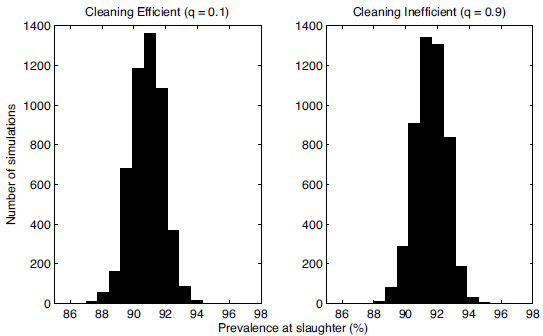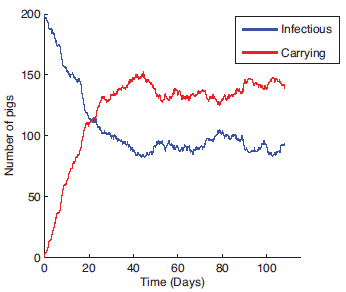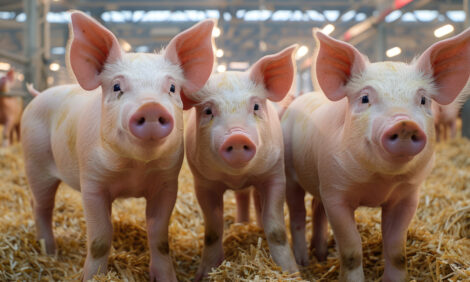



Mathematical Modelling of the Dynamics and Control of Salmonella
Among the conclusions from new research reported by BPEX in no. 21 of its 'Research into Action' series was that pen floor type had a greater effect on Salmonella infections in finishing pigs than the standard of cleaning.Key findings are outlined from a research project carried out at the University of Liverpool which was funded by the Biotechnology and Biological Sciences Research Council and BPEX, as part of a Collaborative Award in Science and Engineering (CASE) studentship.
The aim of the research was to develop mathematical models to understand the dynamics of Salmonella transmission on finishing pig farms in the UK and assess whether farm structure has any effect on this. The aim was to use these models to investigate where control strategies should be aimed.
Two key forms of unit structure (fully slatted and solid floor) were analysed and three models describing Salmonella transmission were developed:
- Single room, fully-slatted floor
- Multiple rooms, fully-slatted floor
- Single room, solid floor
The models identified some key results with regard to on-farm Salmonella dynamics.
A principal finding showed that there is not a single action that can solve the problem but rather, a number of aspects should be targeted.
Shedding
The number of bacteria shed and the probability of infection after Salmonella exposure were found to be key drivers of Salmonella transmission. The importance of the environmental pool on the capacity for transmission was highlighted.
With the standard number of infectious animals entering the unit, the speed in which infection spread within a solid unit was considerably quicker compared to the slatted counterpart. There was, however, minimal difference noted in prevalence prior to slaughter between the models.
When considering an outbreak initiated by a single infectious animal, a noticeable difference between the farm structures emerges:
- For a slatted unit consisting of one large room, it was found that infection took approximately 60 days to become established
- Within the solid-floor unit, however, the dynamics were very different, with infection becoming established within 15 days.
The prevalence immediately prior to slaughter differed considerably between farm types; the slatted unit had a prevalence of approximately 58 per cent, compared to 92 per cent for the solid unit; highlighting the difference in the dynamics.
Infection
One parameter that had a profound affect on Salmonella prevalence within all models was the probability of becoming infected after Salmonella exposure.
Interventions that target the probability of infection after Salmonella exposure and the amount of bacteria shed once an animal becomes infectious should have the biggest effect on Salmonella prevalence.
Cleaning
From simulation of the solid unit model, it was shown that with high shedding, weekly cleaning was not very effective in Salmonella control (Figure 1) and it may be that cleaning must be conducted more frequently in order to minimise the amount of bacteria that pigs are exposed to.

The model showed that fully effective cleaning alone was not enough to eradicate Salmonella once infection was established. However, the proportion of animals infected or carrying Salmonella was lower if cleaning took place on the farm, which implied that cleaning and disinfection was still a worthwhile task.
In Practice
Adopting a range of biosecurity practices is more likely to have a positive impact on on-farm Salmonella levels than trying to encourage producers to adopt all or just one, best practice measures.
As long as stress on farm is minimised, the issue of pigs carrying the bacteria elsewhere on a unit could have minimal effect.
Separating animals that shed bacteria at a high rate was shown to have a positive effect on Salmonella prevalence. The simulation (Figure 2) showed that containing all infectious pigs within one room could be enough to halt transmission. Although this is a relatively simple intervention, difficulties arise in its implementation, as infectious animals are hard to identify. Any advances in the ability to identify infected animals could result in an increased potential to apply this intervention effectively. One method of separating infectious pigs and creating different epidemiological groups is to keep pigs in groups of pens with solid divisions.

Further Research
The results highlighted the need for further research on why some pigs shed very high levels of Salmonella (‘super-shedders’) and how the amount shed could be minimised.
Various vaccines have been developed but are not widely used on farm. Research investigating whether a vaccination would have an effect on decreasing the amount of bacteria shed when an animal becomes infected and/or reducing the susceptibility of the animals could be valuable.
There may be added value in developing a surveillance programme that could identify Salmonella-positive breeder units from Salmonella-negative units. This, in turn, could be an effective way of sourcing piglets from negative units.
November 2013








